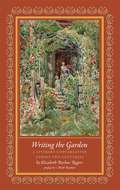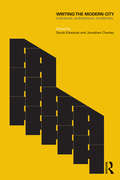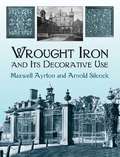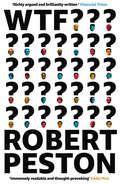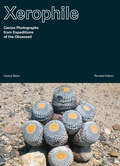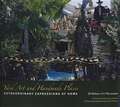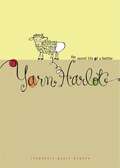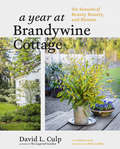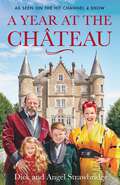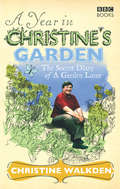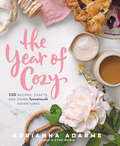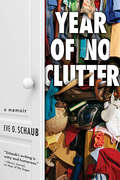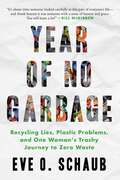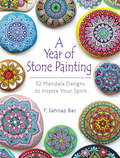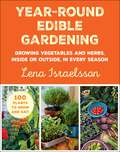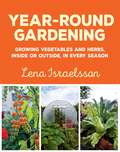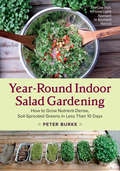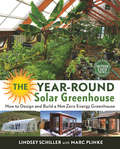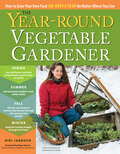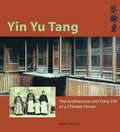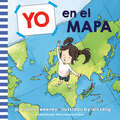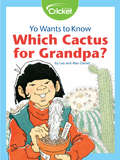- Table View
- List View
Writing the Garden: A Literary Conversation Across Two Centuries
by Elizabeth Barlow RogersGardening, more than most outdoor activities, has always attracted a cult of devotedly literate practitioners; people who like to dig, it would appear, also like to write. And many of them write exceedingly well. In this thoughtful, personal, and embracing consideration of garden writing, garden historian Elizabeth Barlow Rogers selects and discusses the best of these writers. She makes her case by picking delightful examples that span two centuries, arranging the writers by what they did and how they saw themselves: nurserymen, foragers, conversationalists, philosophers, humorists, etc. Her discussions and appreciations of these diverse personalities are enhanced and supported by informed appraisals of their talents, obsessions, and idiosyncrasies, and by extensive extracts from their writings. Rogers provides historical background, anecdotal material, and insight into how these garden writers worked. And wherever appropriate, she illustrates her story with images from their books, so you can not only read what they wrote but also see what they were describing. Since gardens are by their very nature ephemeral, these visual clues from the pages of their books, many reproduced in color, are as close as we will come to the originals. What makes Writing the Garden such a joy to read is that it is not simply a collection of extracts, but real discussions and examinations of the personalities who made their mark on how we design, how we plant, and how we think about what is for many one of life's lasting pleasures. Starting with "Women in the Garden" (Jane Loudon, Frances Garnet Wolseley, and Gertrude Jekyll) and concluding with "Philosophers in the Garden" (Henry David Thoreau, Michael Pollan, and Allen Lacy), this is a book that encompasses the full sweep of the best garden writing in the English language. Writing the Garden is co-published by the New York Society Library and the Foundation for Landscape Studies in association with David R. Godine, Publisher.
Writing the Modern City: Literature, Architecture, Modernity
by Sarah Edwards Jonathan CharleyLiterary texts and buildings have always represented space, narrated cultural and political values, and functioned as sites of personal and collective identity. In the twentieth century, new forms of narrative have represented cultural modernity, political idealism and architectural innovation. Writing the Modern City explores the diverse and fascinating relationships between literature, architecture and modernity and considers how they have shaped the world today. This collection of thirteen original essays examines the ways in which literature and architecture have shaped a range of recognisably ‘modern’ identities. It focuses on the cultural connections between prose narratives – the novel, short stories, autobiography, crime and science fiction – and a range of urban environments, from the city apartment and river to the colonial house and the utopian city. It explores how the themes of memory, nation and identity have been represented in both literary and architectural works in the aftermath of early twentieth-century conflict; how the cultural movements of modernism and postmodernism have affected notions of canonicity and genre in the creation of books and buildings; and how and why literary and architectural narratives are influenced by each other’s formal properties and styles. The book breaks new ground in its exclusive focus on modern narrative and urban space. The essays examine texts and spaces that have both unsettled traditional definitions of literature and architecture and reflected and shaped modern identities: sexual, domestic, professional and national. It is essential reading for students and researchers of literature, cultural studies, cultural geography, art history and architectural history.
Wrought Iron and Its Decorative Use
by Arnold Silcock Maxwell AyrtonA superb treasury of decorative wrought iron, this well-illustrated volume presents an informative survey of the ancient craft's practice throughout England. Its history can be traced simply by admiring the crisp black-and-white illustrations of gates, railings, screens, and other elaborately rendered works. 241 black-and-white illustrations.
WTF: 'Richly argued and brilliantly written' - FT
by Robert PestonA BBC Daily Politics Book of the Year'Richly argued and brilliantly written... a deeply thoughtful analysis that should be mandatory reading for anyone seeking to understand where we have gone wrong.' Vernon Bogdanor, Financial Times'Read the book, everyone. It's a superb analysis of the state we're in and what we can do about it. WTF?' Cole Moreton'An unbuttoned and vitally even-handed analysis that takes in everything from the decline of social mobility to the tyranny of social media.' Metro'Informed, personal, angry and funny: Peston lets rip in an immensely readable and thought-provoking book.' Eddie Mair'Elegant analysis of long term forces driving our politics (inc some solutions). Also a moving tribute to his dad.' Paul Waugh, Huffington Post'Robert Peston's WTF is a work of meticulous analysis that is also an inspiring, and often moving, manifesto for change. Beautifully-written, it is a manual for our times that everyone should read.' Matthew d'Ancona'This gripping and persuasive account of the mess facing liberal democracy ends with some optimism that politicians will rise to the challenge of responding to the tide of hopelessness.' i newspaper'This is a more radical, more passionate, swearier book than I would have expected from Peston - and the better for it... WTF is a great primer on how we ended up here. To escape this mess, we must first understand that.' London Evening Standard'The chapters on Tony Blair's and Gordon Brown's approach to borrowing, the handling of the banking crash and the failure to address economic inequality in its aftermath are well worth bookmarking.' Guardian'Essential reading.' StylistAs with his previous bestsellers, WHO RUNS BRITAIN? and HOW DO WE FIX THIS MESS?, in Robert Peston's new book WTF he draws on his years of experience as a political, economics and business journalist to show us what has gone bad and gives us a manifesto to put at least some of it right. Framed by two letters to his father (who died earlier this year) WTF is Robert Peston's highly personal account of what those who have ruled us for years got so badly wrong, and what we need to do to mend the terrible fractures in our society.With characteristic passion and clarity he looks at what must happen to prevent democracy being subverted by technocratic geniuses with the ability to manipulate social media, how and whether it is possible to make a success of leaving the EU, what the lessons should be of the appalling Grenfell Tower tragedy, whether robots can be stopped from taking our work, what can be done to staunch the widening gap between rich and poor, and how to raise living standards for all.WTF is a trenchant, often entertaining account of the recent past. It is also a call to action, giving hope to all of us who believe that taking back control is not only vital, but possible.
Xerophile, Revised Edition: Cactus Photographs from Expeditions of the Obsessed
by Edited by Cactus StoreAn updated edition of the cult classic, featuring stunning archival photographs of hundreds of the rarest and most spectacular plants on Earth, taken by a motley crew of cactus obsessives &“A catalogue of wonders that most of us will never get to see in person.&”—The New YorkerFrom the people behind Cactus Store comes Xerophile, a photographic collection of these improbable desert wonders in the wild. Drawing on the archives of twenty-five cactus obsessives—from PhD botanist to banker, art teacher to cancer researcher—this revised edition spans eighty years and features new and expanded descriptive notes for all 350+ photos.Xerophile brings together eighty years&’ worth of these explorers&’ remarkable images from some of the world&’s most remote habitats: a peculiar two-leaved plant that lives for millennia in the deserts of Namibia; succulents whose poisonous sap is used by hunters to fell large game in Angola; and cactus that live on snow-covered mountains in Bolivia, sink below ground level to survive droughts in Mexico, are pollinated by bats in Brazil, and grow in pure lava fields of the Galápagos Islands.
Yard Art and Handmade Places: Extraordinary Expressions of Home
by Jill Nokes Pat JasperRelatively few people in America build their own homes, but many yearn to make the places they live in more truly their own. Yard Art and Handmade Places profiles twenty homemakers who have used their yards and gardens to express their sense of individuality, to maintain connections to family and heritage, or even to create sacred spaces for personal and community refreshment and healing. Jill Nokes, an authority on native plants and ecological restoration, traveled across the state of Texas, seeking out residents who had transformed their yards and gardens into oases of art and exuberant personal expression. In this book, she presents their stories, told in their own words, about why they created these handmade places and what their yard art has come to mean to them and to their communities. Rather than viewing yard art as a curiosity or oddity, Nokes treats it as an integral part of home-making, revealing how these places become invested with deep personal or social meaning. Yard Art and Handmade Places celebrates the fact that, despite the proliferation of look-alike suburbs, places still exist where people with ordinary means and skills are shaping space with their own hands to create a personal expression that can be enjoyed by all.
Yarn Harlot: The Secret Life of a Knitter
by Stephanie Pearl-McpheeAn obsessed knitter who can't seem to put the needles down, author Stephanie Pearl-McPhee reveals the tangled and sometimes maniacal path of her knitting triumphs and disasters in this sometimes funny, sometimes sad, but all true story. Stephanie talks about the importance and method of stash, how to set reasonable goals for yourself for knitting, what happens when your family doesn't want you to knit, and the many pitfalls that might befall a knitter.
A Year at Brandywine Cottage: Six Seasons of Beauty, Bounty, and Blooms
by David L. CulpHow to Live Your Best Gardening Life David Culp has spent more than 30 years creating Brandywine Cottage—a sensational year-round garden that provides an abundance of joy, both indoors and out. In his new book, he urges home gardeners everywhere to do the same in their own space. Organized by the garden&’s six natural season, A Year at Brandywine Cottage is packed with fresh ideas and trusted advice, whether it&’s choosing plants for twelve months of interest, weaving edibles into the mix, or bringing the bounty indoors with simple arrangements and homegrown recipes. Packed with glorious images and practical tips, A Year at Brandywine Cottage will inspire you to live a life enriched by nature every day of the year.
A Year at the Chateau: As seen on the hit Channel 4 show
by Dick Strawbridge Angel StrawbridgeTHE ENTERTAINING AND HEARTWARMING SUNDAY TIMES BESTSELLER.Like many couples, Dick and Angel had long dreamed of living in France, but where others might settle for a modest bolthole in the French countryside, the Strawbridges fell in love with a 19th-century fairytale château, complete with 45 rooms, seven outbuildings, 12 acres of land and its own moat.Throwing caution to the wind, Dick and Angel swapped their two-bedroom flat in East London for an abandoned and derelict castle in the heart of the Loire valley and embarked on the adventure of a lifetime with their two young children Arthur and Dorothy.Sharing their full journey for the first time, A Year at the Château follows Dick and Angel from when they first moved to France in the depths of winter and found bedrooms infested with flies, turrets inhabited by bats, the wind rattling through cracked windows, and just one working toilet, which flushed into the moat, through to the monumental efforts that went into readying the château for their unforgettable wedding and their incredibly special first Christmas.Along the way we'll read glorious descriptions of rural life in France, with charming characters, delicious food and wonderful seasonal produce, together with the extraordinary list of renovations and restorations Dick and Angel completed, many of which were never shown on TV.As warm and entertaining as their much-loved show, A Year at the Château is a truly irresistible story of adventure and heart, epic ambitions and a huge amount of hard graft.
A Year at the Chateau: As seen on the hit Channel 4 show
by Dick Strawbridge Angel StrawbridgeTHE ENTERTAINING AND HEARTWARMING SUNDAY TIMES BESTSELLER.Like many couples, Dick and Angel had long dreamed of living in France, but where others might settle for a modest bolthole in the French countryside, the Strawbridges fell in love with a 19th-century fairytale château, complete with 45 rooms, seven outbuildings, 12 acres of land and its own moat.Throwing caution to the wind, Dick and Angel swapped their two-bedroom flat in East London for an abandoned and derelict castle in the heart of the Loire valley and embarked on the adventure of a lifetime with their two young children Arthur and Dorothy.Sharing their full journey for the first time, A Year at the Château follows Dick and Angel from when they first moved to France in the depths of winter and found bedrooms infested with flies, turrets inhabited by bats, the wind rattling through cracked windows, and just one working toilet, which flushed into the moat, through to the monumental efforts that went into readying the château for their unforgettable wedding and their incredibly special first Christmas.Along the way we'll read glorious descriptions of rural life in France, with charming characters, delicious food and wonderful seasonal produce, together with the extraordinary list of renovations and restorations Dick and Angel completed, many of which were never shown on TV.As warm and entertaining as their much-loved show, A Year at the Château is a truly irresistible story of adventure and heart, epic ambitions and a huge amount of hard graft.
A Year in Christine's Garden
by Christine WalkdenA Year in Christine's Garden is the utterly down-to-earth account of one woman's passion for plants. Recounting stories from her hectic life in horticulture, Christine Walkden's diary is a heartwarming account of octogenarian neighbours, living with a film crew and helping friends with their gardening needs. Reflecting all the charm of her BBC2 television series, Christine's narrative paints a picture of the day-to-day beauty that surrounds her. She likes being outside, she likes walking her dog Tara, she likes watching the light change and she enjoys those little moments when everything seems right in the world.With irrepressible enthusiasm, she interweaves tips and advice to prove that the best gardens are approachable and achievable. Forget fashion, forget trends - Christine's garden is about no-nonsense planting and growing what you enjoy. As the year progresses, this warm, but frank diary brings to life all the moments of pride, excitement, relaxation and laugh-out-loud fun that make Christine's garden a haven of contentment.
The Year of Cozy: 125 Recipes, Crafts, and Other Homemade Adventures
by Adrianna AdarmeFrom the author of the popular blog, A Cozy Kitchen, comes a beautifully photographed one-stop-shop book with all the recipes and projects you’ll need for some cozy inspiration this holiday season—and all year long. You’ll love Adrianna Adarme’s easy-to-follow instructions and will enjoy getting lost in her warm and comforting photographs. Organized by the months of the year and by categories as “Live,” “Do,” and “Make, ” this book offers ideas for activities, recipes, and DIY projects that make the little moments in life just as exciting as the big. Adarme gives us special (but totally doable) things we can do for others and ourselves. From quick recipes to easy crafts, she focuses on simple, inexpensive undertakings that have a big reward: happiness. The Year of Cozy will surely inspire you to march into your kitchen and craft closet to make something you can truly be proud of.
Year of No Clutter: A Memoir
by Eve SchaubEve has a problem with clutter. Too much stuff and too easily acquired, it confronts her in every corner and on every surface in her house. When she pledges to tackle the worst offender, her horror of a "Hell Room," she anticipates finally being able to throw away all of the unnecessary things she can't bring herself to part with: her fifth-grade report card, dried-up art supplies, an old vinyl raincoat.But what Eve discovers isn't just old CDs and outdated clothing, but a fierce desire within herself to hold on to her identity. Our things represent our memories, our history, a million tiny reference points in our lives. If we throw our stuff in the trash, where does that leave us? And if we don't...how do we know what's really important?Everyone has their own Hell Room, and Eve's battle with her clutter, along with her eventual self-clarity, encourages everyone to dig into their past to declutter their future. Year of No Clutter is a deeply inspiring—and frequently hilarious — examination of why we keep stuff in the first place, and how to let it all go.
Year of No Garbage: Recycling Lies, Plastic Problems, and One Woman's Trashy Journey to Zero Waste
by Eve O. Schaub"Eve&’s brave and honest experiment reveals the shocking impact of the throwaway society we&’ve become and at the same time showing small ways we can all do better.&” —Rebecca Prince-Ruiz, founder of Plastic Free JulyYear of No Garbage is Super Size Me meets the environmental movement. In this book Eve O. Schaub, humorist and stunt memoirist extraordinaire, tackles her most difficult challenge to date: garbage. Convincing her husband and two daughters to go along with her, Schaub attempts the seemingly impossible: living in the modern world without creating any trash at all. For an entire year. And- as it turns out- during a pandemic. In the process, Schaub learns some startling things: that modern recycling is broken, and single stream recycling is a lie. That flushable wipes aren&’t flushable and compostables aren&’t compostable. That plastic drives climate change, fosters racism, and is poisoning the environment and our bodies at alarming rates, as microplastics are being found everywhere, from the top of Mount Everest to the placenta of unborn babies. If you&’ve ever thought twice about that plastic straw in your drink, you&’re gonna want to read this book.
A Year of Stone Painting: 52 Mandala Designs to Inspire Your Spirit
by F Sehnaz BacYou can craft a new mandala every week for one year with this full-color guide by the author of the bestselling The Art of Stone Painting. F. Sehnaz Bac, an artist and seasoned archaeologist, presents step-by-step instructions for fifty-two projects. Her easy-to-follow guide will show you how to transform ordinary stones into inspirational works of art. The mandala — derived from the Sanskrit word for "circle" — represents the universe, and the symbol has long been instrumental to sacred rituals and meditative practices. This treasury of radiant designs presents patterns for stone paintings, each of which is accompanied by a one-word mantra — relax, tranquil, spirit, dream, believe, and other uplifting terms. A few projects are meant to be painted on sea glass, leaves, or shells, but most are based on Bac's popular interpretations of classic stone-based styles. Colorful photographs accompany simple instructions for a year of crafting inspiration.
Year-Round Edible Gardening: Growing Vegetables and Herbs, Inside or Outside, in Every Season
by Lena IsraelssonWant to get home-grown spices in the middle of winter? Eat fresh vegetables in the spring? Sow in the summer to harvest in the fall? Lena Israelsson's book, Year-Round Edible Gardening, is a practical guide for those who want to extend their growing season. And double, perhaps triple, their harvest. Growing year-round is possible, and this book can teach you the best methods to do it the right way.Year-Round Edible Gardening includes inspiring and expert tips on which vegetables, herbs, and spices suit the different seasons. Certain plants can even be harvested in the middle of winter if handled correctly. Others, like microgreens, herbs, and hydroculture, can create the perfect indoor gardens. This book will teach readers to know the difference between cold and hot weather plants, which growing methods are best suited for different plants, and when to plant and harvest. They&’ll learn about sowing; coverage with plastic, glass, or fiber weaves; and fertilization—creating a fruitful and fertile soil is the linchpin of all cultivation and one of the book's most important parts.
Year-Round Gardening: Growing Vegetables and Herbs, Inside or Outside, in Every Season
by Lena IsraelssonWant to get home-grown spices in the middle of winter? Eat fresh vegetables in the spring? Sow in the summer to harvest in the fall? Lena Israelsson's book, Year-Round Gardening, is a practical guide for those who want to extend their growing season. And double, perhaps triple, their harvest. Growing year round is possible, and this book can teach you the best methods to do it the right way.Year-Round Gardening includes inspiring and expert tips on which vegetables, herbs, and spices suit the different seasons. Certain plants can even be harvested in the middle of winter if handled correctly. Others, like microgreens, herbs, and hydroculture, can create the perfect indoor gardens. This book will teach readers to know the difference between cold and hot weather plants, which growing methods are best suited for different plants, and when to plant and harvest. They’ll learn about sowing; coverage with plastic, glass, or fiber weaves; and fertilization—creating a fruitful and fertile soil is the linchpin of all cultivation and one of the book's most important parts.
Year-Round Indoor Salad Gardening
by Peter BurkeThe Low-Tech, No-Grow-Lights Approach to Abundant Harvest Year-Round Indoor Salad Gardening offers good news: with nothing more than a cupboard and a windowsill, you can grow all the fresh salad greens you need for the winter months (or throughout the entire year) with no lights, no pumps, and no greenhouse. Longtime gardener Peter Burke was tired of the growing season ending with the first frost, but due to his busy work schedule and family life, didn't have the time or interest in high-input grow lights or greenhouses. Most techniques for growing what are commonly referred to as "microgreens" left him feeling overwhelmed and uninterested. There had to be a simpler way to grow greens for his family indoors. After some research and diligent experimenting, Burke discovered he was right--there was a way! And it was even easier than he ever could have hoped, and the greens more nutrient packed. He didn't even need a south-facing window, and he already had most of the needed supplies just sitting in his pantry. The result: healthy, homegrown salad greens at a fraction of the cost of buying them at the market. The secret: start them in the dark. Growing "Soil Sprouts"--Burke's own descriptive term for sprouted seeds grown in soil as opposed to in jars--employs a method that encourages a long stem without expansive roots, and provides delicious salad greens in just seven to ten days, way earlier than any other method, with much less work. Indeed, of all the ways to grow immature greens, this is the easiest and most productive technique. Forget about grow lights and heat lamps! This book is a revolutionary and inviting guide for both first-time and experienced gardeners in rural or urban environments. All you need is a windowsill or two. In fact, Burke has grown up to six pounds of greens per day using just the windowsills in his kitchen! Year-Round Indoor Salad Gardening offers detailed step-by-step instructions to mastering this method (hint: it's impossible not to succeed, it's so easy!), tools and accessories to have on hand, seeds and greens varieties, soil and compost, trays and planters, shelving, harvest and storage, recipes, scaling up to serve local markets, and much more.
The Year-Round Solar Greenhouse: How to Design and Build a Net-Zero Energy Greenhouse
by Lindsey Schiller Marc PlinkeComprehensive coverage of passive solar greenhouse design including material selection, building methods and how to store thermal energy using a variety of simple and innovative strategies. Over a dozen case studies provide real-life inspiration, capped off with how-to guidance for building a durable, energy-efficient greenhouse. Variations include underground and aquaponic greenhouses and integrating solar panels to grow off-grid, year-round.
The Year-Round Vegetable Gardener: How to Grow Your Own Food 365 Days a Year, No Matter Where You Live
by Niki Jabbour Joseph De ScioseEven in winter’s coldest months you can harvest fresh, delicious produce. Drawing on insights gained from years of growing vegetables in Nova Scotia, Niki Jabbour shares her simple techniques for gardening throughout the year. Learn how to select the best varieties for each season, the art of succession planting, and how to build inexpensive structures to protect your crops from the elements. No matter where you live, you’ll soon enjoy a thriving vegetable garden year-round.
Yin Yu Tang
by Nancy BerlinerIn the late Qing dynasty (1644-1911) a Chinese merchant named Huang built a house for his family in a small, remote village in the southeastern region of Huizhou in China's Anhui Province. He named the house Yin Yu Tang. For seven generations, members of the Huang family ate, slept, laughed, cried, married, and gave birth in the house. By the mid-1990s, the surviving Huang family members moved away leaving the house empty and abandoned. In 1997 the house was moved to the Peabody Essex Museum in Salem, Massachusetts, and opened as a permanent exhibit.Yin Yu Tang provides a fascinating, in-depth look at Chinese domestic culture, architecture, craftsmanship, history, and the impact of these influences on individual lives. Nancy Berliner, one of the country's foremost experts on Chinese furniture and arts, takes the reader on a tour of this unique homestead providing detail on Yin Yu Tang's architecture, construction methods, decoration, furniture, and family heirlooms. She weaves a story of Chinese domestic life, culture, and the remarkable restoration and reconstruction at the Peabody Essex Museum in America.
Yin Yu Tang
by Nancy BerlinerIn the late Qing dynasty (1644-1911) a Chinese merchant named Huang built a house for his family in a small, remote village in the southeastern region of Huizhou in China's Anhui Province. He named the house Yin Yu Tang. For seven generations, members of the Huang family ate, slept, laughed, cried, married, and gave birth in the house. By the mid-1990s, the surviving Huang family members moved away leaving the house empty and abandoned. In 1997 the house was moved to the Peabody Essex Museum in Salem, Massachusetts, and opened as a permanent exhibit.Yin Yu Tang provides a fascinating, in-depth look at Chinese domestic culture, architecture, craftsmanship, history, and the impact of these influences on individual lives. Nancy Berliner, one of the country's foremost experts on Chinese furniture and arts, takes the reader on a tour of this unique homestead providing detail on Yin Yu Tang's architecture, construction methods, decoration, furniture, and family heirlooms. She weaves a story of Chinese domestic life, culture, and the remarkable restoration and reconstruction at the Peabody Essex Museum in America.
Yin Yu Tang
by Nancy BerlinerIn the late Qing dynasty (1644-1911) a Chinese merchant named Huang built a house for his family in a small, remote village in the southeastern region of Huizhou in China's Anhui Province. He named the house Yin Yu Tang. For seven generations, members of the Huang family ate, slept, laughed, cried, married, and gave birth in the house. By the mid-1990s, the surviving Huang family members moved away leaving the house empty and abandoned. In 1997 the house was moved to the Peabody Essex Museum in Salem, Massachusetts, and opened as a permanent exhibit.Yin Yu Tang provides a fascinating, in-depth look at Chinese domestic culture, architecture, craftsmanship, history, and the impact of these influences on individual lives. Nancy Berliner, one of the country's foremost experts on Chinese furniture and arts, takes the reader on a tour of this unique homestead providing detail on Yin Yu Tang's architecture, construction methods, decoration, furniture, and family heirlooms. She weaves a story of Chinese domestic life, culture, and the remarkable restoration and reconstruction at the Peabody Essex Museum in America.
Yo en el mapa (Me on the Map Spanish Edition)
by Joan Sweeney¡Los mapas pueden mostrar dónde estás en cualquier parte del mundo! Un querido éxito de ventas que ayuda a los niños a descubrir su lugar en el planeta, desde su habitación al resto del mundo.¿En dónde estás? ¿En dónde está tu habitación? ¿En dónde está tu casa? ¿En dónde está tu ciudad?¡Toma un mapa y descúbrelo! Esta lúdica introducción a los mapas te muestra lo fácil que es encontrar en dónde vives y el lugar que ocupas en el mundo, empezando por tu propia casa y ciudad, y extendiéndose hacia otros territorios y países. Yo en el mapa te da el vocabulario para describir en qué parte del mundo te encuentras y lo fácil que es encontrar los lugares que conoces y amas con la ayuda de un mapa.
Yo Wants to Know: Which Cactus for Grandpa?
by Lea DanielGrandpa teaches Yo about how cactuses grow, thrive, and protect themselves.
